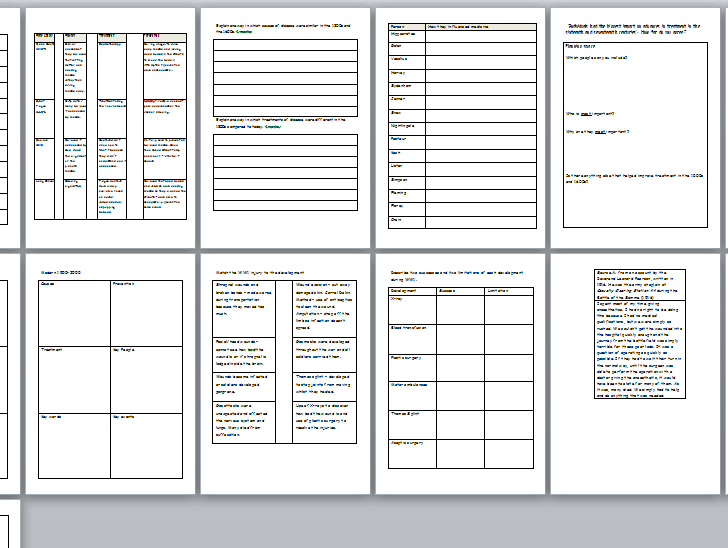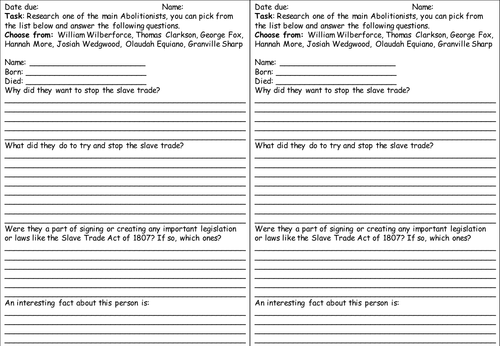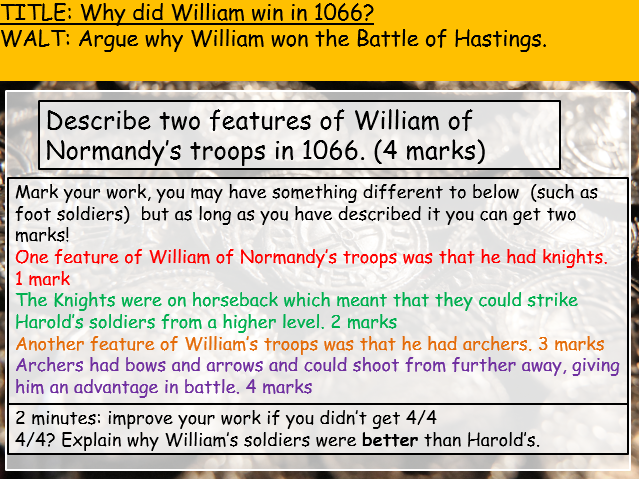
177Uploads
75k+Views
23k+Downloads
History

REVISION Medicine Through Time and Western Front Overview
An hour and a half lesson aimed at intervention prior to the examination.
pupils are given an a5 booklet to follow along with the session, parts of which can be completed at home to build knowledge as last minute revision. This is the last session I use prior to Paper One.
Pupils cover:
key people, key discoveries, skills for all question types, source evaluation and judgement.

Design your own Norman castle (Stone keep and motte and bailey)
Full lesson
Pupils are given a budget and key features of a castle, they must make their own castle and then must attack their partner's castle. Aimed at year 7 pupils studying life in Norman England.

Who was Henry VIII?
Introductory lesson for Henry the Eighth. Pupils compare reasons Henry is remembered as a good and a bad king to come to a conclusion as to how they think he should be remembered.
Pupils also answer an interpretation question - training for the new GCSE reforms.
WALT: Explore the type of king Henry VIII is remembered as.
Level 3: Identify what makes a good king.
Level 4: Describe the type of person Henry VIII was.
Level 5: explain how features of Henry’s personality made him a good king.
Level 6: assess the main difference between two interpretations.

Spartacist Uprising and Kapp Putsch (Weimar and Nazi Germany: Edexcel 9-1)
Pupils will:
WALT: Examine challenges to the Weimar government by the left and right.
Identify features of left and right wing politics.
Describe the Spartacist Revolt and the Kapp Putsch.
Explain why Germany was weak after the attacks.
Analyse a source to explain why it is useful.
Included is a fully differentiated how useful question including differentiated structure strips.

How useful (skills builder/revision lesson) (WW1 Medicine on the Western Front: Edexcel 9-1)
THIS FULLY DIFFERENTIATED LESSON HAS BEEN PLANNED TO FIT HALF WAY THROUGH THE WW1 MEDICINE UNIT (AFTER THE CHAIN OF EVACUATION) BUT WILL ALSO BE DELIVERED AS A REVISION LESSON AT THE END OF THE COURSE TO CURRENT EXAM CLASSES.
I HAVE USED MY KNOWLEDGE AS A PAPER THREE MARKER TO CREATE A ‘HOW TO GUIDE’ FOR ANSWERING THE 8 MARK UTILITY QUESTION.
WALT: explore the key skills needed to reach full marks on a how useful question.
Recall the stages of the chain of evacuation.
Describe how to structure a how useful question using the mark scheme.
Explain how useful a source is to a historian enquiring about the chain of evacuation.
Analyse our work using the mark scheme to identify successes and targets.
task one: pupils put the chain of evacuation into order and describe each stage using key words only
task two: pupils annotate a mark scheme, can be done under a visualiser, using the same method as the examiners of paper three (Judgement, analysis, knowledge) discussion with pupils about what key things mean within the mark scheme.
task three: pupils annotate the sources in pairs, question prompts on the board to support less able (underline three key facts etc) before going over it on the visualiser
task four: Pupils answer a how useful question in timed conditions - this can be marked or I have included a peer/self assessment activity where pupils mark their own work and improve it using colour coding and a full mark answer.
i have included a worksheet summarising the chain of evacuation in case this is being used as a revision lesson rather than within original teaching - this may be useful for lower ability pupils within a normal scheme of work as well.

Abolition in America and Britain - two lessons, worksheets and homework
Lesson 8 and 9 in slavery scheme of work.
Worksheets included within the lesson powerpoint as hidden slides.
Homework:
Profile of a famous abolitionist.
Lesson 1: Abolition in Britain - Focus on Slave Trade Act 1807, reasons for and against, William Wilberforce
Lesson 2: Abolition in America - focus on comparison of Britain and America, Abraham Lincoln, civil war

Pointless - Medicine Through Time
Designed to cover all units of medicine through time as a last lesson of term activity.

Johnson County War: Causes, conduct, consequences. (American West (Edexcel history 9-1))
Lesson that explores the causes, conduct and consequences of the JCW.
All tasks fully differentiated for HA and LA.

Cattle Industry Decline (American West (Edexcel history 9-1))
Lesson that explores the consequences of the end of the cattle industry.
Includes differentiated carousel and exam question (two consequences of…)

Norman Conquest (Edexcel history 9-1) Why did William win the Battle of Hastings?
Fully differentiated lesson with 'how far do you agree' exam question and skills work at the end of the lesson.
Pupils colour code the reasons William/Harold's tactics were better, they then analyse their leadership before considering whether it was luck/God's will that led to William winning the Battle of Hasting's.

KS3 The Blitz (WW2) How useful sources
This is part of a scheme of work that prepares KS3 pupils for the GCSE reforms and skills required for KS4.
Pupils will be provided with opportunities within the lesson to build on their ability to write in PEEL paragraphs, make inferences, and analyse a source to explain why it is useful.
Pupils will:
1 identify what has happened to a building that has been bombed and explain how they know this using an inference
2. watch Pathe primary sources to examine the experiences of Londoners during the Blitz
3. Describe where shelter would be found and explain which was best and why (PEEL)
4. Analyse a source to explain why it is useful for a historian examining the experiences of Londoners during WW2.

REVISION Plots against Elizabeth and Spanish Armada (Edexcel 9-1: Early Elizabethan England)
In this session pupils will cover:
who challenged Elizabeth and why?
Revolt of the Northern Earls
Ridolfi Plot
Throckmorton and Babington
Spanish Armada: causes, conduct consequences
Narrative account practice

Consequence and Importance skills lesson (American West Edexcel 9-1)
aim: consolidate knowledge of key principles and build consequence and importance of skills
Starter: Match the event with the consequences on the worksheet
Pupils have a worksheet with two consequences for each significant event in the unit
establish the difference between consequence and importance
Colour code consequences into importance question types (key themes like destruction of Indian culture and Settlement of the west)
attempt an importance of question as a class
create a question using question stems and answer it themselves.
Bundle

Early Elizabethan England Revision Bundle inc. Mock (Edexcel 9-1)
This revision bundle covers the content required to revise Paper Two of Early Elizabethan England (Edexcel 9-1).
Sessions included in this bundle:
Key people (Elizabeth, Walsingham, Mary QoS)
Life and problems (poverty, education, entertainment)
Plots against Elizabeth (Ridolfi, Babington, Throckmorton, Northern Earls, Armada)
Exploration (Drake and Raleigh with exam practice)
Full mock also included
Bundle

American West Revision Bundle (designed for Edexcel 9-1)
7 revision sessions focused around building skills towards the new GCSE content - narrative account, importance and consequences.

Elizabethan England: Poverty and the Poor Laws
WALT: Investigate poverty in Tudor England.
Level 3: Identify reasons people live in poverty today.
Level 4: Describe reasons people lived in poverty in Tudor England.
Level 5: Explain why categories were needed to cope with the poor and what those categories were.
Level 6: Evaluate how fair these categories were, give reasons why.

The Rising Against Tostig Godwinson (Anglo-Saxon and Norman England (Edexcel 9-1))
WALT: Evaluate the reasons and response to the rebellion against Tostig.
2-3: Recall key facts about the role of an earl.
4-5: Describe reasons Saxons did not like Tostig.
6-7: Explain why factors would make somebody rebel.
8-9*: evaluate whether Harold was right to exile his brother.
Pupils will recall the roles of an earl for the starter.
They will then go through each of the reasons the Saxons hated Tostig (printable handout that pupils highlight and annotate)
They write a letter to Harold (LA) or a response from Harold (HA) explaining why they are upset/ how they are going to offer help
They analyse the impact this had upon Harold’s claim and whether he was right to exile his brother.

'What is history?' introductory lesson (What is History? (KS3))
The first lesson in a scheme of work designed to introduce KS3 pupils to the concept of history and help them acquire historical skills.
WALT: identify key historical skills and explain why history is important.
L3: Define what the study of history is.
L4: Describe key skills a good historian needs.
L5: Explain why history is important.
L6: compare history to another subject and justify which you think is most important.
Pupils define what history is in their own words.
Investigation of blooms words, describe, explain, infer etc.
Discussion of what history is, prior learning and a video.
Lesson includes homework for pupils to complete, teacher can use homework to gain a baseline of pupils ability.

WW1 REVISION: Gas! (EDEXCEL 9-1: Western Front MTT)
WALT Analyse sources to explain how gas was used during WW1.
Recall key features of the main battles of WW1.
Identify key features of the first use of mustard gas.
Describe the three types of gas used in WW1 in detail. Explain how they harmed a soldier.
Apply: Analyse sources to evaluate their utility.
The first task recaps the main features of battles in WW1. the main body of the lesson revises key knowledge of gas attacks, before focusing keenly on source skills using the IS-SAYS-KNOW structure and modelling the answer to the first source as a group.

Were the slaves really free after the Emancipation Proclamation?
To follow American abolition lesson.
Differentiated carousel task that considers the positive and negative developments that faced freedmen following the E.P:
Jim Crow, Black Codes, etc.
Carousel hidden slides to print
Full lesson, build up towards a how far do you agree question.




















